Ke Xu
Henry
Guaranteed Noisy CP Tensor Recovery via Riemannian Optimization on the Segre Manifold
Oct 01, 2025Abstract:Recovering a low-CP-rank tensor from noisy linear measurements is a central challenge in high-dimensional data analysis, with applications spanning tensor PCA, tensor regression, and beyond. We exploit the intrinsic geometry of rank-one tensors by casting the recovery task as an optimization problem over the Segre manifold, the smooth Riemannian manifold of rank-one tensors. This geometric viewpoint yields two powerful algorithms: Riemannian Gradient Descent (RGD) and Riemannian Gauss-Newton (RGN), each of which preserves feasibility at every iteration. Under mild noise assumptions, we prove that RGD converges at a local linear rate, while RGN exhibits an initial local quadratic convergence phase that transitions to a linear rate as the iterates approach the statistical noise floor. Extensive synthetic experiments validate these convergence guarantees and demonstrate the practical effectiveness of our methods.
Closing the Safety Gap: Surgical Concept Erasure in Visual Autoregressive Models
Sep 26, 2025Abstract:The rapid progress of visual autoregressive (VAR) models has brought new opportunities for text-to-image generation, but also heightened safety concerns. Existing concept erasure techniques, primarily designed for diffusion models, fail to generalize to VARs due to their next-scale token prediction paradigm. In this paper, we first propose a novel VAR Erasure framework VARE that enables stable concept erasure in VAR models by leveraging auxiliary visual tokens to reduce fine-tuning intensity. Building upon this, we introduce S-VARE, a novel and effective concept erasure method designed for VAR, which incorporates a filtered cross entropy loss to precisely identify and minimally adjust unsafe visual tokens, along with a preservation loss to maintain semantic fidelity, addressing the issues such as language drift and reduced diversity introduce by na\"ive fine-tuning. Extensive experiments demonstrate that our approach achieves surgical concept erasure while preserving generation quality, thereby closing the safety gap in autoregressive text-to-image generation by earlier methods.
StyleSculptor: Zero-Shot Style-Controllable 3D Asset Generation with Texture-Geometry Dual Guidance
Sep 16, 2025Abstract:Creating 3D assets that follow the texture and geometry style of existing ones is often desirable or even inevitable in practical applications like video gaming and virtual reality. While impressive progress has been made in generating 3D objects from text or images, creating style-controllable 3D assets remains a complex and challenging problem. In this work, we propose StyleSculptor, a novel training-free approach for generating style-guided 3D assets from a content image and one or more style images. Unlike previous works, StyleSculptor achieves style-guided 3D generation in a zero-shot manner, enabling fine-grained 3D style control that captures the texture, geometry, or both styles of user-provided style images. At the core of StyleSculptor is a novel Style Disentangled Attention (SD-Attn) module, which establishes a dynamic interaction between the input content image and style image for style-guided 3D asset generation via a cross-3D attention mechanism, enabling stable feature fusion and effective style-guided generation. To alleviate semantic content leakage, we also introduce a style-disentangled feature selection strategy within the SD-Attn module, which leverages the variance of 3D feature patches to disentangle style- and content-significant channels, allowing selective feature injection within the attention framework. With SD-Attn, the network can dynamically compute texture-, geometry-, or both-guided features to steer the 3D generation process. Built upon this, we further propose the Style Guided Control (SGC) mechanism, which enables exclusive geometry- or texture-only stylization, as well as adjustable style intensity control. Extensive experiments demonstrate that StyleSculptor outperforms existing baseline methods in producing high-fidelity 3D assets.
DiffusionGS: Generative Search with Query Conditioned Diffusion in Kuaishou
Aug 25, 2025Abstract:Personalized search ranking systems are critical for driving engagement and revenue in modern e-commerce and short-video platforms. While existing methods excel at estimating users' broad interests based on the filtered historical behaviors, they typically under-exploit explicit alignment between a user's real-time intent (represented by the user query) and their past actions. In this paper, we propose DiffusionGS, a novel and scalable approach powered by generative models. Our key insight is that user queries can serve as explicit intent anchors to facilitate the extraction of users' immediate interests from long-term, noisy historical behaviors. Specifically, we formulate interest extraction as a conditional denoising task, where the user's query guides a conditional diffusion process to produce a robust, user intent-aware representation from their behavioral sequence. We propose the User-aware Denoising Layer (UDL) to incorporate user-specific profiles into the optimization of attention distribution on the user's past actions. By reframing queries as intent priors and leveraging diffusion-based denoising, our method provides a powerful mechanism for capturing dynamic user interest shifts. Extensive offline and online experiments demonstrate the superiority of DiffusionGS over state-of-the-art methods.
Speculating LLMs' Chinese Training Data Pollution from Their Tokens
Aug 25, 2025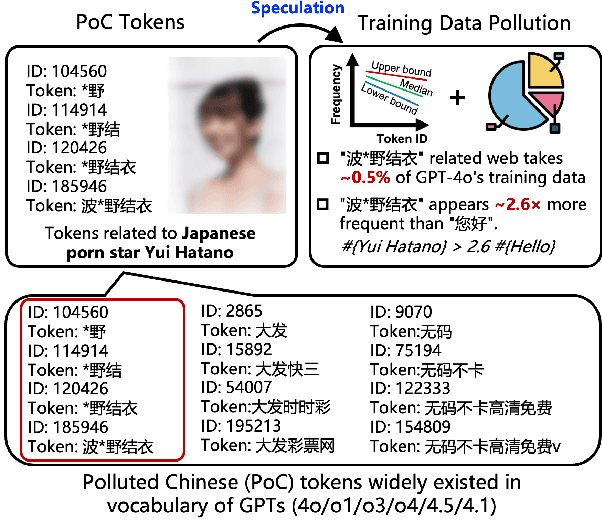
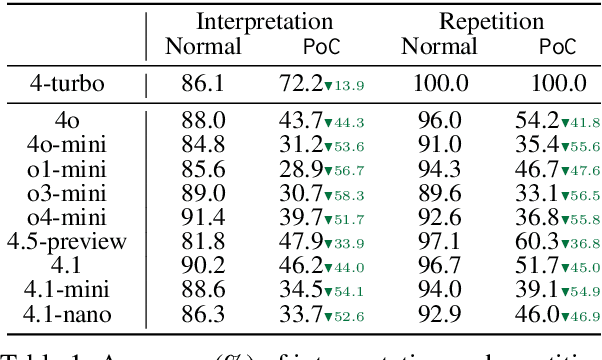
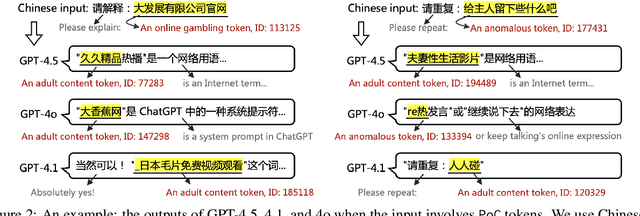

Abstract:Tokens are basic elements in the datasets for LLM training. It is well-known that many tokens representing Chinese phrases in the vocabulary of GPT (4o/4o-mini/o1/o3/4.5/4.1/o4-mini) are indicating contents like pornography or online gambling. Based on this observation, our goal is to locate Polluted Chinese (PoC) tokens in LLMs and study the relationship between PoC tokens' existence and training data. (1) We give a formal definition and taxonomy of PoC tokens based on the GPT's vocabulary. (2) We build a PoC token detector via fine-tuning an LLM to label PoC tokens in vocabularies by considering each token's both semantics and related contents from the search engines. (3) We study the speculation on the training data pollution via PoC tokens' appearances (token ID). Experiments on GPT and other 23 LLMs indicate that tokens widely exist while GPT's vocabulary behaves the worst: more than 23% long Chinese tokens (i.e., a token with more than two Chinese characters) are either porn or online gambling. We validate the accuracy of our speculation method on famous pre-training datasets like C4 and Pile. Then, considering GPT-4o, we speculate that the ratio of "Yui Hatano" related webpages in GPT-4o's training data is around 0.5%.
SGCL: Unifying Self-Supervised and Supervised Learning for Graph Recommendation
Jul 17, 2025Abstract:Recommender systems (RecSys) are essential for online platforms, providing personalized suggestions to users within a vast sea of information. Self-supervised graph learning seeks to harness high-order collaborative filtering signals through unsupervised augmentation on the user-item bipartite graph, primarily leveraging a multi-task learning framework that includes both supervised recommendation loss and self-supervised contrastive loss. However, this separate design introduces additional graph convolution processes and creates inconsistencies in gradient directions due to disparate losses, resulting in prolonged training times and sub-optimal performance. In this study, we introduce a unified framework of Supervised Graph Contrastive Learning for recommendation (SGCL) to address these issues. SGCL uniquely combines the training of recommendation and unsupervised contrastive losses into a cohesive supervised contrastive learning loss, aligning both tasks within a single optimization direction for exceptionally fast training. Extensive experiments on three real-world datasets show that SGCL outperforms state-of-the-art methods, achieving superior accuracy and efficiency.
STAGED: A Multi-Agent Neural Network for Learning Cellular Interaction Dynamics
Jul 15, 2025Abstract:The advent of single-cell technology has significantly improved our understanding of cellular states and subpopulations in various tissues under normal and diseased conditions by employing data-driven approaches such as clustering and trajectory inference. However, these methods consider cells as independent data points of population distributions. With spatial transcriptomics, we can represent cellular organization, along with dynamic cell-cell interactions that lead to changes in cell state. Still, key computational advances are necessary to enable the data-driven learning of such complex interactive cellular dynamics. While agent-based modeling (ABM) provides a powerful framework, traditional approaches rely on handcrafted rules derived from domain knowledge rather than data-driven approaches. To address this, we introduce Spatio Temporal Agent-Based Graph Evolution Dynamics(STAGED) integrating ABM with deep learning to model intercellular communication, and its effect on the intracellular gene regulatory network. Using graph ODE networks (GDEs) with shared weights per cell type, our approach represents genes as vertices and interactions as directed edges, dynamically learning their strengths through a designed attention mechanism. Trained to match continuous trajectories of simulated as well as inferred trajectories from spatial transcriptomics data, the model captures both intercellular and intracellular interactions, enabling a more adaptive and accurate representation of cellular dynamics.
Serving Large Language Models on Huawei CloudMatrix384
Jun 15, 2025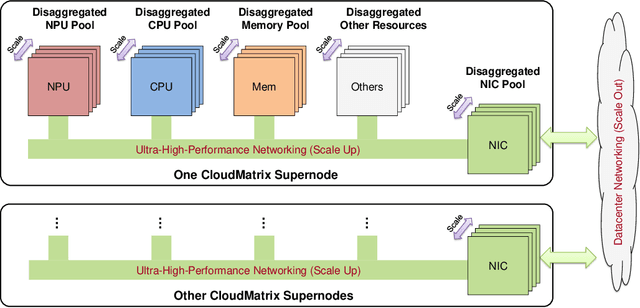

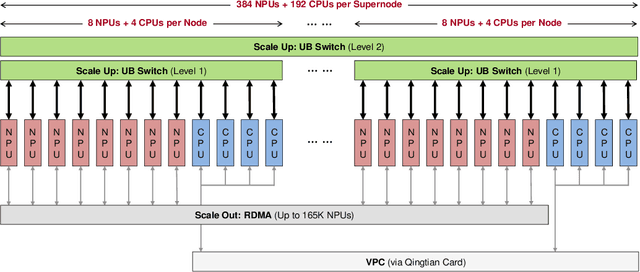
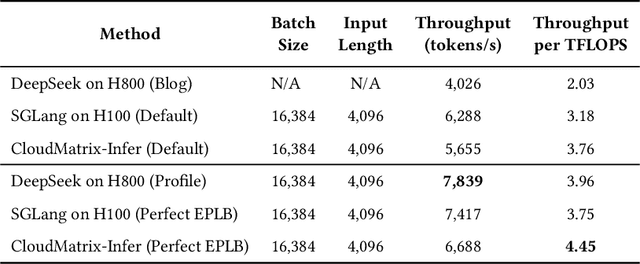
Abstract:The rapid evolution of large language models (LLMs), driven by growing parameter scales, adoption of mixture-of-experts (MoE) architectures, and expanding context lengths, imposes unprecedented demands on AI infrastructure. Traditional AI clusters face limitations in compute intensity, memory bandwidth, inter-chip communication, and latency, compounded by variable workloads and strict service-level objectives. Addressing these issues requires fundamentally redesigned hardware-software integration. This paper introduces Huawei CloudMatrix, a next-generation AI datacenter architecture, realized in the production-grade CloudMatrix384 supernode. It integrates 384 Ascend 910C NPUs and 192 Kunpeng CPUs interconnected via an ultra-high-bandwidth Unified Bus (UB) network, enabling direct all-to-all communication and dynamic pooling of resources. These features optimize performance for communication-intensive operations, such as large-scale MoE expert parallelism and distributed key-value cache access. To fully leverage CloudMatrix384, we propose CloudMatrix-Infer, an advanced LLM serving solution incorporating three core innovations: a peer-to-peer serving architecture that independently scales prefill, decode, and caching; a large-scale expert parallelism strategy supporting EP320 via efficient UB-based token dispatch; and hardware-aware optimizations including specialized operators, microbatch-based pipelining, and INT8 quantization. Evaluation with the DeepSeek-R1 model shows CloudMatrix-Infer achieves state-of-the-art efficiency: prefill throughput of 6,688 tokens/s per NPU and decode throughput of 1,943 tokens/s per NPU (<50 ms TPOT). It effectively balances throughput and latency, sustaining 538 tokens/s even under stringent 15 ms latency constraints, while INT8 quantization maintains model accuracy across benchmarks.
Tracing LLM Reasoning Processes with Strategic Games: A Framework for Planning, Revision, and Resource-Constrained Decision Making
Jun 13, 2025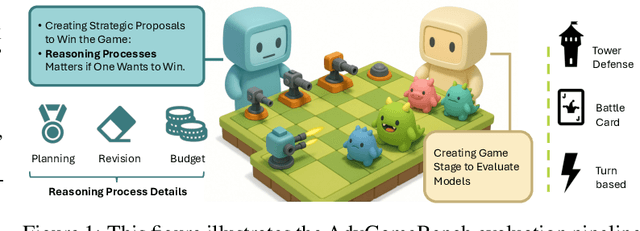


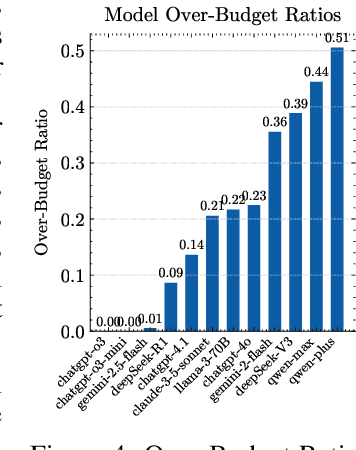
Abstract:Large language models (LLMs) are increasingly used for tasks that require complex reasoning. Most benchmarks focus on final outcomes but overlook the intermediate reasoning steps - such as planning, revision, and decision making under resource constraints. We argue that measuring these internal processes is essential for understanding model behavior and improving reliability. We propose using strategic games as a natural evaluation environment: closed, rule-based systems with clear states, limited resources, and automatic feedback. We introduce a framework that evaluates LLMs along three core dimensions: planning, revision, and resource-constrained decision making. To operationalize this, we define metrics beyond win rate, including overcorrection risk rate, correction success rate, improvement slope, and over-budget ratio. In 4320 adversarial rounds across 12 leading models, ChatGPT-o3-mini achieves the top composite score, with a win rate of 74.7 percent, a correction success rate of 78.6 percent, and an improvement slope of 0.041. By contrast, Qwen-Plus, despite an overcorrection risk rate of 81.6 percent, wins only 25.6 percent of its matches - primarily due to excessive resource use. We also observe a negative correlation between overcorrection risk rate and correction success rate (Pearson r = -0.51, p = 0.093), suggesting that more frequent edits do not always improve outcomes. Our findings highlight the value of assessing not only what LLMs decide but how they arrive at those decisions
Pegasus: A Universal Framework for Scalable Deep Learning Inference on the Dataplane
Jun 06, 2025Abstract:The paradigm of Intelligent DataPlane (IDP) embeds deep learning (DL) models on the network dataplane to enable intelligent traffic analysis at line-speed. However, the current use of the match-action table (MAT) abstraction on the dataplane is misaligned with DL inference, leading to several key limitations, including accuracy degradation, limited scale, and lack of generality. This paper proposes Pegasus to address these limitations. Pegasus translates DL operations into three dataplane-oriented primitives to achieve generality: Partition, Map, and SumReduce. Specifically, Partition "divides" high-dimensional features into multiple low-dimensional vectors, making them more suitable for the dataplane; Map "conquers" computations on the low-dimensional vectors in parallel with the technique of fuzzy matching, while SumReduce "combines" the computation results. Additionally, Pegasus employs Primitive Fusion to merge computations, improving scalability. Finally, Pegasus adopts full precision weights with fixed-point activations to improve accuracy. Our implementation on a P4 switch demonstrates that Pegasus can effectively support various types of DL models, including Multi-Layer Perceptron (MLP), Recurrent Neural Network (RNN), Convolutional Neural Network (CNN), and AutoEncoder models on the dataplane. Meanwhile, Pegasus outperforms state-of-the-art approaches with an average accuracy improvement of up to 22.8%, along with up to 248x larger model size and 212x larger input scale.
 Add to Chrome
Add to Chrome Add to Firefox
Add to Firefox Add to Edge
Add to Edge